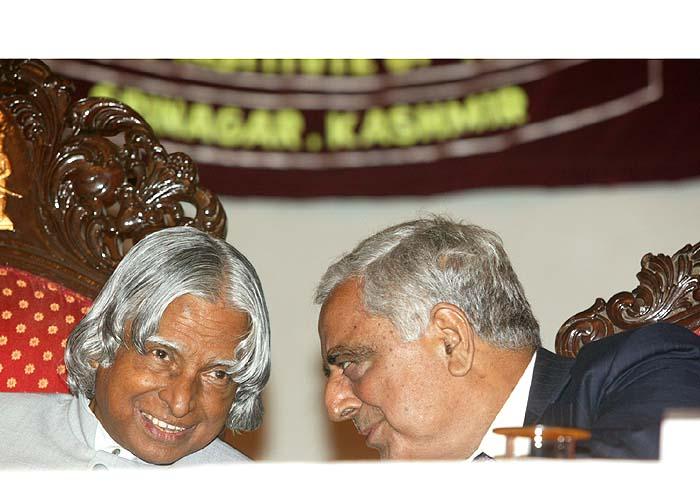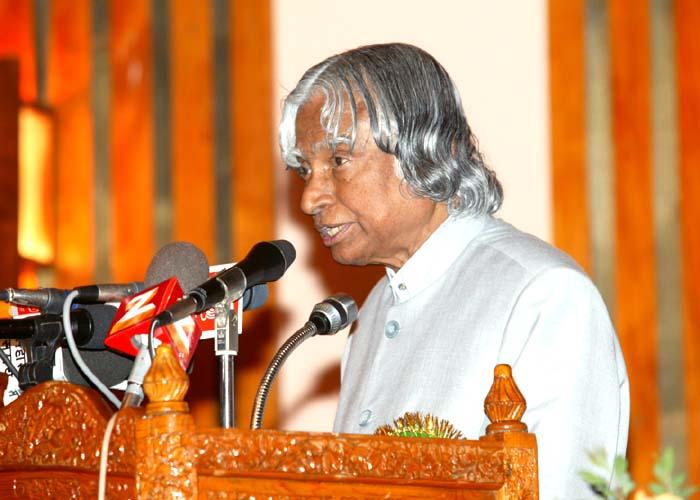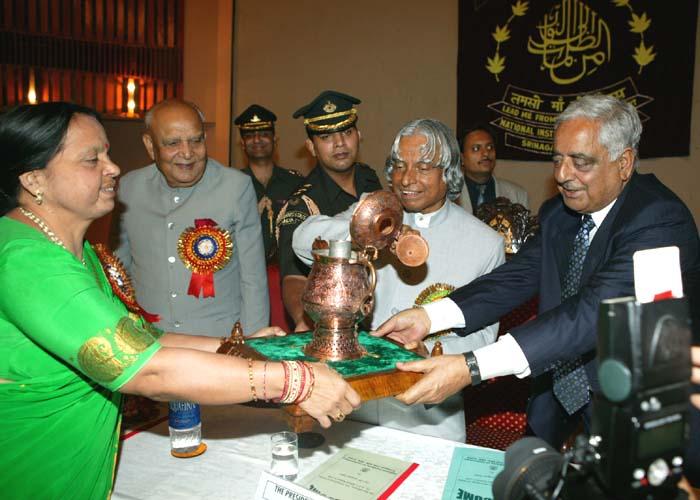Interaction With The Students Of National Institute Of Technology, Srinagar
Srinagar : 19-08-2004
Mission of Developed India and the Youth
I am indeed delighted to participate in the interaction meet with the students of National Institute of Technology. I greet the students, and congratulate the Faculty and staff of NIT, for shaping the young minds. I always cherish interaction with the students and faculties in this intellectually alert environment. Here I am reminded of the question asked by a young girl from Nagaland, during my visit. She asked me, Mr President, I would like to live in a happy, prosperous and safe India. Will you please tell me when and how it will be achieved? And tell Mr President, how can I contribute as a student for such a mission? This is a very important question for all of you. You have to ask yourself, what I can give to our country? Keeping this in my mind, I have chosen the title of my talk, Mission of Developed India and the Youth.
Freedom movement and scientists
The first vision of independence in 1857 triggered the process of change. Later the freedom movement brought the best of leaders in politics, public life, music, poetry, literature and science. This movement was driven patriotism and sacrifice with a unity of mind and purpose. There was a desire in many Indians to excel and surpass foreigners in every field of life. This led to demonstrating their individual talent. In Chandra, the biography of the famous astrophysicist S Chandra Sekhar by Kameshwar Wali, it reads:
Before 1910, there were no (Indian) scientists of international reputation but after the first world war between 1920 and 1925, suddenly five scientists of international repute emerged. They were JC Bose, CV Raman, Meghnad Saha, Srinivasa Ramanjan and Prof Chandra Sekhar himself. I have associated this remarkable phenomenon with the need for self-expression, which became a dominant motive among the young during the national movement. It was a part of the national movement to assert oneself. We could show the west in their own realm that we were equal to them. Like science, the first vision of the freedom movement generated top class leaders in every walk of life.
I am always reminded of an incident of significance that took place sometime in 1901 when a ship was sailing from Bombay to Europe. Two great human beings were travelling in that ship. They introduced each other. They were Swami Vivekananda and Jamsetji Nusserwanji Tata. Swamiji asked Nausserwanji Tata where he was going and what was the mission. Jamsetji Nusserwanji Tata said, Swamiji I am going with a mission to bring steel industry to my country. Friends it was 1901, when India was ruled by the British. Swamiji said, it is indeed a beautiful mission. However, I would like to give you a small caution. Whatever amount you spend to get the process of making steel, you should invest in learning the metallurgical science of making steel also. I will prefer, you start an institute, a laboratory to do advanced research on the subject. What a prophetic statement!. A big planning took place. That planning had two parts: the first part was to start steel manufacturing plant presently at Jamshedpur. After this he donated one sixth of his property for establishing an Institute for material research, which is the Indian Institute of Science at Bangalore.
The message we get is that in the pre independence period we had visionary leaders who had contributed to the freedom movement through achievements in science, technology and industry.
After 57 years of independence, aspirations are mounting that India should become a developed country. This is the second vision for the nation. How we can prepare ourselves for this challenge?
second vision for the nation
To become a developed India, the essential needs are (a) India has to be economically and commercially powerful, at least to be one of the four top nations in terms of size of the economy. Our target should be a sustained GDP growth of more than 10 percent annually and that the people below the poverty line to be reduced to near zero.
(b) near self-reliance in defence and needs of weapon, equipment with no umbilical attached to the outside world.
(c) India should have a right place in world forums. Technology Vision 2020 is a pathway to realise this cherished mission.
We have identified five areas where India has a core competence for an integrated action.
(1) Agriculture and food processing - we have to place a target of 360 million tons of food and agricultural production. Other areas of agriculture and agro food processing would bring prosperity to rural people and speed up economic growth.
(2) Reliable and quality electric power for all parts of the country.
(3) Education and Healthcare - we have seen, based on experience, education and healthcare are inter related.
(4) Information Communication Technology - This is one of our core competence. We believe, this area can be used to promote education in remote areas and also to create national wealth.
(5) Strategic sectors - This area, fortunately, witnessed growth in nuclear technology, space technology and defence technology. Other areas like Advanced Sensors and Materials would need a push.
These five areas are closely inter-related and would lead to national, food, and economic security. A strong partnership among the R&D, academia, Industry and the community as a whole with Government departments will be essential to accomplish the Vision.
Connectivity for rural development
Nearly 700 million people of India live in the rural areas in 600,000 villages. Connectivity of village complexes providing economic opportunities to all segments of people is an urgent need to bridge the rural-urban divide, generate employment and enhance rural prosperity. Repeating what we did before for several decades with more of the same may not be the way to proceed further. We need to innovate to increase connectivities to the villages making clusters out of them even while retaining their individualities.
The integrated methods which will bring prosperity to rural India are: the physical connectivity of the village clusters through quality roads and transport; electronic connectivity through tele-communication with high bandwidth fiber optic cables reaching the rural areas from urban cities and through internet kiosks; knowledge connectivity through education, skill training for farmers, artisans and craftsmen and entrepreneurship programmes. These three connectives will lead to economic connectivity through starting of enterprises with the help of banks, micro credits and marketing of the products. The integrated method envisages a mission mode empowered management structure with executive powers at the local implementation levels and by reducing the transactional costs through simplification of procedures of governance.
Creating such village clusters depending upon the region and population will cost between Rs.100-200 crores per cluster. After initial short-term employment during construction etc., we may have to plan for initiating actions for providing regular employment opportunities for 3000 - 5000 people. This has to be done by creating new market driven enterprises brought by investors. If the industrial areas (IT, BT, Cottage industries) are marketed well they can attract investors and thus lead to local wealth generation. Such value addition will also generate high value employment in service and support sector for about 10000 people. In addition we need to promote entrepreneurship in the rural areas and equip people with skills for their own self-employment meeting the needs of modern economy and society. Some of these persons may also turn out to be innovators and create new big industries.
Development of J&K
J&K has approximately 6400 inhabited villages with a population of over 8 million. The population is spread in hilly terrain and 75 per cent of them live in villages. Their main occupation is agriculture and cottage industries such as carpet weaving, silk products, handicrafts etc. The area is rich in forest trees such as Chinar, deodar, pine and fir. Walnut, willow, almond, cider and saffron add to the rich flora of Jammu & Kashmir. The state also has a rich crop of fruits particularly Apple, Leh Berry, cherry. Value addition to fruits and vegetables is very important.
The entire state of J&K can have 100 PURAs each having approximately 60 villages and an average population of over fifty thousand. The task will be to create physical, electronic, knowledge connectivity to these village clusters leading to economic connectivity of the cluster.
The role of NIT in national development
The NIT Faculty and students as part of their project work, should develop the connectivity and economic development of a few chosen clusters as a economically viable business model. This will give them an ample opportunity to make their education practically relevant and useful to the society.
Their development programme can include improvements in the existing systems of agriculture and the handicrafts of the villages and implementation of modern technological methods. The NIT Faculty can train the students in entrepreneurship programme which will enable the students to provide leadership in some of the villager cluster enterprises. NIT students in turn can train the villagers through vocational training programmes on modern methods of agriculture, handicrafts and cottage industries. Research can also be carried out in hill agriculture. There is a laboratory in Leh called FRL (Field Research Laboratory) specialized in hill agriculture, animal husbandry and poultry in extreme cold climate.
Role Model
The institution and the faculty members should work towards making themselves as role models in their own discipline. This will attract best of students to the institution. In addition to quality and value based education, the formal education in entrepreneurship is required, which will make the students do things differently, thinking beyond boundaries, being bold, and be able to take risks. In addition, a normalization programme is required for developing communication, aptitude and attitudinal skills among the students coming from various rural areas, which will provide a level playing field for these students.
Networking of Institutes of Excellence
NIT should develop its own core competence and it should be unique. It is possible to facilitate collaborative knowledge sharing through Tele-Education and knowledge connectivity with other National Institutes of Technology, Indian Institute of Technology and Indian Institute of Science. This will help the faculty members to share the knowledge with other leading engineering institutions and promote self-learning by students.
We have several institutions of higher learning in engineering and technology in the country. These include the IISc, IITs, NITs and many leading technology universities. One of the powers of networking is that it is disruptive technology and a knowledge multiplier. In order to make availability of knowledge across these institutions uniform, I recommend that the Nation takes up on priority basis to network these institutions with a very high speed backbone so that real time multiple streams of video and audio can be shared across. This will make our dream of virtual university a reality.
Now I would like to answer some of the questions asked by the NIT students.
1. How India will be able to make a successful manned mission to moon?
- Asma Ranshid, 3rd Mechanical.
Ans. At the moment the Lunar mission aims at launching a satellite which will orbit around the moon and acquire scientific data. All the technologies needed for this mission is available with the Indian Space Research Organisation. Launching of manned mission will be the next step.
2. What is the future of electrical energy being transmitted via satellite instead of transmission lines?
- Laraib Muzamil, 7th Electrical.
Ans. Launching of Solar power satellite will be another challenge to the world community.
3. How India is going to develop in the field of material and electronics?
- Kuldeep Singh Chib, 7th Mechanical.
Ans. Nano Technology is going to play a major part in the field of materials and electronics. Nano science deals with 1 to 100 nano metre size moleculer structure. Nano science will make a revolution in electronics, bio-technology and materials. Certain research and industrialization are in progress. A mission mode planning is essential to reap the benefits of nano science and technology.
4. As you know that the rest mass of photon is zero. Also any particle having rest mass equal to zero can attain the velocity of light. According to Einstein mass of particle increase with increase in velocity. Since when photon strikes anything it behaves as particle. Why then its mass is not infinite at that time as its velocity is equal to the velocity of light?
-Bital Ahmed Shah, 7th E & C.
Ans. Though physicists say that photons are massless, it is possible to assign a "relativistic mass" to a photon which depends upon its wavelength. This relativistic mass can not be infinite. Due to finite wavelength the mass of the photon is finite even at the velocity of light.
5. Why organisations like HAL, NAL, DRDO & ISRO have not as yet started their research related activities in the valley?
- Mir Ajaz Ahmed, 5th Civil.
Ans. DRDO has a Field Research laboratory at Leh which concentrates on High Altitude Agriculture, Poultry and Animal Husbandry. Also SASE of DRDO has detachments at Srinagar and many other places in the valley which in collaboration with the Department of Science and Technology works on mountain meteorology, and they give avalanche prediction to the Armed Forces and Civilian Sectors. Communication and Remote Sensing Data provided by ISRO is widely being used by Geologists and Communication Specialists. The Indian Astronaumical Obersvatory (IAO) the high altitude station of IIA, is situated at an altitude of 4500 metres above MSL to the north of western Himalayas. The cloudless skies and low atmospheric water vapour make it one of the best sites in the world for optical, infrared sub millimeter and millimeter wavelengths.
6. What steps our Government is taking to set up software & electronics industries in the valley?
-Rasleen Kaur, 7th E & C.
Ans. There is a Software Technology Park in Srinagar. The CEDT was established quite some time back. The State Government is also now inviting number of entrepreneurs to come forward and set up Software and Electronics Industries in the valley. Because of its clean environment and the cold climate the valley is suitable for electronics and computer hardware.
7. Why we are not at par with other countries in producing nobel laureates?
-Anabreen Anjum, 7th Civil.
Ans. Science is a life long mission and a full time passion. Emphasis on sustained high quality science, funding scientific institutions and encouraging the young scientists have commenced in a big way recentlty in our country. The type of infrastructure which has come now in various organizations in the country demands high quality research. I hope in a decade many things can happen.
8. How do you justify the statement preparation for war as a defence for peace.
-Rahul, 5th Mechanical.
Ans. My view is the following for the last 3000 years India has been invaded by many countries. Alaxander invaded India then British ruled, French had the colony, dutch had the colony, portugese had set up colony. Why? India needs peace for its progress. When all around the nation countires have nuclear weapons India cannot sit and do tapas. Strength respects strength. Whatever we have done in defence is only to defend our freedom. At no time India either in the past or in the future would ever invade any nation and for example our nuclear policy enunciates no first use . That means defending the country is the foremost mission.
9. In our State, we have a policy to recruit diploma & degree holders in the ratio 3:1 for J.E. Post. Diploma engineers are preferred over highly qualified B.E. / B.Tech. degree candidates. How can you help us in solving this problem?
-Sikander Choudhary, 7th Civil.
Ans. In our country, in all our states and UTs, we have small number of jobs to offer from the government side. Presently, a three pronged approach to generate entrepreneurs, who would in turn generate employment is being launched. Schools and colleges will teach the art of entrepreneurship to the students. The banks will provide the venture capital through hassle free loans. This approach, as in developed countries, has to spread in India and create more enterprises so that instead of job seekers we will have job providers.
NITs should offer special courses on Entrepreneurship for the engineering graduates passing out from this institution. They should also work with Industrial units and banks for creating new enterprises in the valley. The entrepreneur developed by this Institute will manage these Enterprises. This will be the long-term solution for finding creative and productive employment for the engineering graduates.
10. Our valley is having a high potential for hydro electric power and wind energy but exploitation is not at satisfactory level. What steps are being taken by the Government in this direction?
-Binyamin Ahmed, 7th Mech.
Ans. Hydro potential in the state is 14000 MW. So far 1474 MW power is being generated. 960 MW power plant is under construction. There are 30 projects for which feasibility reports have been prepared for generating additional power to the extent 2480 MW of hydro power. There are constraints due to some international treaties in certain river regions. There is no plan for wind energy while there are solar power has been generated and used in villages of Kargil and Leh. Solar power potential is very high because 320 days sunlight is available. Mini hydels of 1 MW capacity is being explored. Ministry of NES is exploring the possibility of generating through Geo thermal potential at Puga valley.
11. In view of N.I.T. Srinagar (formerly R.E.C. Srinagar) being an institution of Excellence, established in 1960, having distinguished faculty, best facilities, located at backdrop of beautiful hills besides the lake and topographically best located. We are not having any I.I.T. in J & K, Punjab and Himachal Pradesh. Why our Institute is not being transformed into I.I.T.?
- Fouzia Nazir, 7th E&C.
Ans. My view is you bring a name to NIT in performance and a brand. One day you will get it. In this connection I would like recall a famous couplet from Thirukkural of Saint Thiruvalluvar.

It means that whatever may be the depth of the river or lake or pond, whatever may be the condition of the water, the lilly flower always comes out and blossoms. Similarly, if there is a definite determination to achieve a goal even if it is impossible to achieve, the man succeeds.



